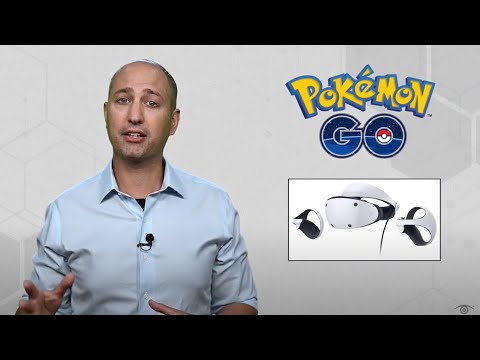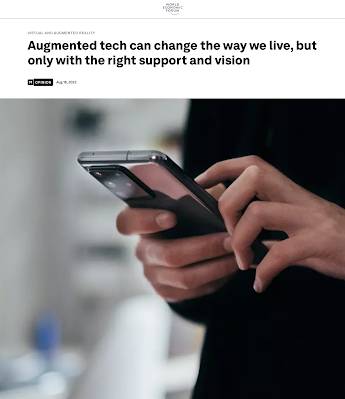
This article was last updated on August 26, 2022
Canada: ![]() Oye! Times readers Get FREE $30 to spend on Amazon, Walmart…
Oye! Times readers Get FREE $30 to spend on Amazon, Walmart…
USA: ![]() Oye! Times readers Get FREE $30 to spend on Amazon, Walmart…
Oye! Times readers Get FREE $30 to spend on Amazon, Walmart…
The World Economic Forum’s Augmented Society – A Chip Implant for Every Human
In a recent opinion piece on the World Economic Forum’s website:
….we can see how technology will “transform society” thanks to the use of augmented reality, at least in the eyes of the global ruling class.
Let’s start with a definition of augmented reality:
“Augmented reality (AR) is the integration of digital information with the user’s environment in real time. Unlike virtual reality (VR), which creates a totally artificial environment, AR users experience a real-world environment with generated perceptual information overlaid on top of it.
Augmented reality is used to either visually change natural environments in some way or to provide additional information to users. The primary benefit of AR is that it manages to blend digital and three-dimensional (3D) components with an individual’s perception of the real world. AR has a variety of uses, from helping in decision-making to entertainment.
AR delivers visual elements, sound and other sensory information to the user through a device like a smartphone or glasses. This information is overlaid onto the device to create an interwoven experience where digital information alters the user’s perception of the real world. The overlaid information can be added to an environment or mask part of the natural environment.“
Here is a video showing the difference between AR and VR:
As noted above, augmented reality can be delivered using smartphones and glasses but it can also be delivered using tablets and contact lenses as shown in this video:
Augmented reality programs are also used by the military including machine vision, recognition of objects and gestures and can display data on a vehicle’s windshield. The U.S. military also uses AR in an eyepiece called Tactical Augmented Reality which mounts on a helmet and can be used to locate another soldier’s location.
AR can also be used as follows:
1.) retail businesses allow consumers to see how products will look on them or in their home prior to purchase.
2.) entertainment and gaming.
3.) tools and measurement of different 3D points in a user’s environment.
4.) architects can use AR to visualize a project.
Now let’s go back to the WEF opinion piece on augmented reality. When the piece was first published, this is what it looked like:
Now, thanks to those nasty web denizens who just love to propagate a conspiracy theory, WEF has been forced to add a disclaimer to the beginning of the article:
In case you can’t read the small print, here is the disclaimer in full:
“Help us prevent the spread of disinformation
This article has been intentionally misrepresented on sites that spread false information. Please read the piece for yourself before sharing or commenting.
The World Economic Forum is committed to publishing a wide array of opinions. Misrepresenting content diminishes open conversations.”
There’s nothing that the World Economic Forum hates more than hate directed at itself. On the upside, since I’ve read the piece for myself from beginning to end, according to the World Economic Forum, I’m entitled to weigh in.
Given the WEF’s penchant for all things technological, they note the following three key points about the implementation of a society based on augmented reality:
1.) Augmented reality technology has the ability to transform society and individual lives, particularly in health care and mobility.
2.) As much as visual and hearing aids are a part of our lives today, implant technologies could become the norm in future.
3.) Stakeholders in society will need to agree on how to ethically make these amazing technologies a part of our lives.
The author notes that society is making the first strides toward an augmented society in two ways:
1.) using AR technology as an extension of rehabilitation (i.e. eyeglasses, prosthetics, cochlear implants) to restore a lost or impaired function.
2.) using AR technology in healthy individuals in all stages of life from childhood learning environments to professionals at work to ambitious senior citizens. Examples include night vision googles, exoskeletons and brain-computer interfaces.
The author provides two specific examples:
1.) trying to converse in a noisy environment – AR technology would allow you to use glasses or earbuds that temporarily improve your ability to hear.
2.) children with ADD could use AR technology to block off excessive stimulation that distracts them through the use of extra visual and audio guidance.
Now, let’s get to one of the key points of the opinion piece. The author notes that technology will become intertwined in the body in the form of implants and that:
“….As scary as chip implants may sound, they form part of a natural evolution that wearables once underwent. Hearing aids or glasses no longer carry a stigma. They are accessories and are even considered a fashion item. Likewise, implants will evolve into a commodity….
….Getting an implant is obviously more invasive than picking up a pair of glasses. Generally, implants will be linked to medical conditions. The extent to which a particular device becomes common will depend on the technology’s functionality and how far it’s integrated into your body and daily life(style).”
Fortunately, we can remove hearing aids and glasses when we don’t want to use them; the same cannot be said for implantable technology.
Of course, the braintrust at the WEF love the very idea of implants as you can see in these quotes:
“Brain implants take us one step further and allow us to tap straight into the body’s “operating system…
An indispensable wearable device may be implanted under the skin as a first approach or in the belly if needed….there may be other implants that influence the nerves of the peripheral nervous system or the information highways that connect the spinal cord and brain to organs and limbs.“
In an attempt to convince us that AR technology is for the betterment of humanity, the author states that:
“Just as with wearables, no one turns their head anymore for medical necessities like hearing aids or pulse monitors. Even in an educational and professional setting, smart goggles, phones, wristbands and the like are commonplace. Gaming is the next target. The question is whether implants will follow a similar evolution. Health? Plausible. Education and profession? Potentially….
If the idea of a chip in your body makes you cringe, consider all the pharmaceuticals you take without question.“
Once again, you can stop taking pharmaceuticals should you decide that you no longer wish to ingest them. The same cannot be said for implantable technology unless you happen to be handy with a scalpel and a mirror.
At the beginning of this article, I noted that the WEF had added a disclaimer to the beginning of this opinion piece, stating that certain websites had been spreading false information about the WEF’s intentions. Here are the sentences that have caused many to ponder the real motives of AR:
“The limits on implants are going to be set by ethical arguments rather than scientific capacity. For example, should you implant a tracking chip in your child? There are solid, rational reasons for it, like safety.“
With a sentence like that, it’s pretty hard for the WEF to deny that their stakeholders, the world’s wealthiest and most influential individuals, are not enthralled with the concept of a chip in every human being starting with the youngest and most vulnerable among us which will be soft-sold to the serfs as a means of improving their lives.
Here is yet another video on the use of AR to enhance human beings, turning us into Homo sapiens 2.0 and the ethical debate that will be brought to the forefront as a result:
Given the rapidly growing implementation of digital identification and the fact that governments and Big Tech thrive on their ability to track and trace our every move, it is only logical to those who are capable of critical thinking that there are serious issues regarding privacy and civil rights that accompany the implementation of implants and other augmented technologies. As well, while we are being told that AR technology will be the ultimate solution for all that ails humanity, in fact, there is no guarantee that this technology will result in an improved quality of life for the useless eater class.




Be the first to comment